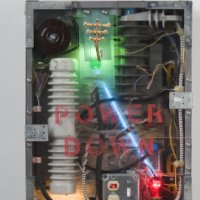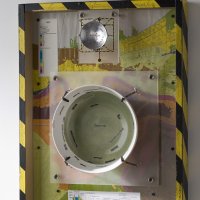There’s an unattributed quote written in mosaic at the end of my sidewalk that reads: “To be an artist is never to avert your eyes.”

It’s been a long time now since we watched while the citizens of one of the world’s most uniquely beautiful cities suffered devastating loss and misery—watched as TV crews moved with seeming ease into a city where our government said it couldn’t go.
Some artists are still watching.
New Orleans-based sculptor and jeweler Thomas Mann has created Storm Cycle, a touring show about Hurricane Katrina’s effects. Mann first visited New Orleans in 1977 and moved there about 20 years ago. His approach to the disaster is almost clinical: We get no mud, no chemical spill, no smell from the corpses left floating for days and days. Mann shows one work about an abandoned dog, one about a cat, and only one directly confronting the human privation and desolation.
The artist—who was out of town when the storm struck and was lucky enough to lose neither home nor studio—has carefully, with his jeweler’s skill and sensibility, built his works in multiple layers. He refers to this technique as “float”—a method he used for years without any idea about the word’s prophetic weight.
Mann often begins a piece with cartography. “Will it Float?” is created with green glass shapes defining the flooded areas, overlaid on a map of the Gulf Coast region. The map is enclosed in a kind of shadowbox frame, and at the top is a beautifully crafted rowboat made of red wire. Beneath the boat is a Plexiglas rectangle enclosing a printout of an aerial photograph of rescue personnel in boats level with the rooftops of houses.

A photo of a mauve-colored brick house sits atop a background of sculpted bricks in “Markings, No. 4—Wall Street.” The viewer sees spray-painted symbols on the wall, used by rescue teams to say whether the house has been checked, and what was found there. A white boxer stands beside the steps of his home, alone and waiting. Accompanying text describes the animal’s timidity with the strangers who tried to help him. The home’s entry is protected with a scrolled wrought-iron door, and at the top of his work Mann has recreated this intricate passageway; before it he has placed a lovely carved portrait of the dog.
But despite these poignant touches, there persists in Storm Cycle a certain detachment. Charts, graphs, maps, measurements and responsibly documented facts about engineering and weather phenomena add a chill accompaniment to the assemblages.
“We Live in a Bowl” is framed with the kind of black-and-yellow tape used by police. The center object is a plastic bowl printed with different typefaces that identify different sectors of the city: The Garden District is represented by an elaborate 18th-century script. The 9th Ward is delineated in hand-drawn letters. And the Superdome gets a heavy, contemporary font from which it is most difficult to avert the eyes.
[Connie Bostic is an Asheville-based painter and writer.]
Thomas Mann’s Storm Cycle remains on view at Blue Spiral 1 (38 Biltmore Ave.) through Tuesday, Aug. 28. 251-0202.



Before you comment
The comments section is here to provide a platform for civil dialogue on the issues we face together as a local community. Xpress is committed to offering this platform for all voices, but when the tone of the discussion gets nasty or strays off topic, we believe many people choose not to participate. Xpress editors are determined to moderate comments to ensure a constructive interchange is maintained. All comments judged not to be in keeping with the spirit of civil discourse will be removed and repeat violators will be banned. See here for our terms of service. Thank you for being part of this effort to promote respectful discussion.